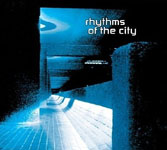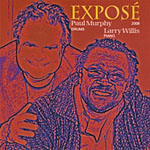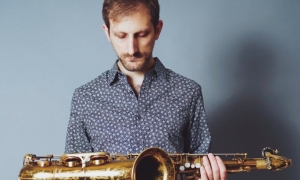Home » Jazz Articles » Interview » Bob Stewart: Brassy Bass Lines
Bob Stewart: Brassy Bass Lines
I found out that it wasn't just about the notes to play. On tuba, you had to find out a way to organize your breathing technique so as not to disturb the rhythm section.
 Over his 40-year career, tubaist Bob Stewart has redefined his instrument's role in modern jazz. His thundering, breathy grooves and fluid improvisations have been integral to the work of a who's who of creative musicians, including Arthur Blythe, David Murray and Carla Bley, as well as to Stewart's own impressive discography as a leader.
Over his 40-year career, tubaist Bob Stewart has redefined his instrument's role in modern jazz. His thundering, breathy grooves and fluid improvisations have been integral to the work of a who's who of creative musicians, including Arthur Blythe, David Murray and Carla Bley, as well as to Stewart's own impressive discography as a leader. All About Jazz: For those who aren't aware, would you talk a little about your background?
Bob Stewart: Well, my father was in the air force and playing in the Negro League, for a baseball team in South Dakota. My mother went to visit him and gave birth and immediately we came back to New York City. So, I was in New York City and then we went to Newport, RI in 1953 and then to Philadelphia in 1960. I moved to New York City to play music in 1968. I started to play trumpet in Newport around 1955, or something like that. I played trumpet up to the end of my second year in college, and in my third year I switched to tuba because of some embouchure problems. I got my first gig the year after college, and I started teaching. I played at a place called Your Father's Mustache. Some of the few tuba gigs were at Your Father's Mustache and The Red Garter; they were both Dixieland gigs. Dave Bargeron was over at The Red Garter and Howard Johnson sometimes worked at the club, and that's how I first met Howard. I was coming in on weekends to work the club and he would come in to play. That whole winter [1967], I came in on weekends from Philly to work at the club and hang out with Howard. By June of the next year, I moved to New York.
AAJ: These were all Dixieland gigs?
BS: That was the only thing available for a tuba to do, except for an orchestra gig. As a matter of fact, there were a couple of instances at that time—one was with Carla Bley, who had just started JCOA [Jazz Composer's Orchestra] and she would hire Howard or me in that situation. The only other one at that point was with Gil Evans. He had a tuba in his band, so sometimes when Howard couldn't make it, I would sub for him in Gil's band. Those were my first experiences in jazz, or contemporary jazz.
 AAJ: The JCOA was great. Was it a working band?
AAJ: The JCOA was great. Was it a working band? BS: Not really. We would play at [NYU's] Loeb Student Center. Also, Carla used to give concerts over at The Public Theater. That's where we recorded the live album with Pharoah Sanders (Communications, 1968).
AAJ: How did you end up recording with Charles Mingus?
BS: That was a few years later. Again, I was subbing for Howard on a tuba chair and Mingus dug both of our playing, so he made it a double chair. He had Howard on baritone and I would play tuba, or vice versa. That was in 1971. We did a live concert called "Live at Avery Fisher Hall" and we did the studio album called Let My Children Hear Music (Columbia, 1971) at the old Columbia studio with those high ceilings in midtown. I didn't know it at the time, but I was a part of a certain kind of history.
AAJ: Was it early on in New York that you met Arthur Blythe and Lester Bowie?
BS: I met Arthur in Gil Evans' band. He was in Gil's band in the early '70s. He asked me, "I'm going to put a group together. Can you play bass on the tuba?" At the time, I was playing Dixieland, but I didn't have a clue as to what to do in contemporary jazz. So I said, "Yeah, sure, of course," [laughs] and then I went to school and figured out how to do it. I found out that it wasn't just about the notes to play. On tuba, you had to find out a way to organize your breathing technique so as not to disturb the rhythm section. A bassist doesn't have to breathe to produce a sound on his instrument, but I had to figure out how to breathe and not disturb the "ring ding-a-ding ding-a-ding ding-a-ding," which is a whole process in itself. Arthur was very benevolent in helping me figure out how to do that and allowing me the time to figure that out while we were playing. So it was an interesting time for me. There was a whole myriad of things that I couldn't go to anyone to ask, like how to use an amplifier, what type of microphone to use, how to place it on the tuba.
AAJ: It was just you and Howard Johnson at the time?
BS: Yeah, but primarily his approach to playing the instrument was kind of like a horn. He was up front in the band more, playing melodies. I would watch Howard and try to do the things he was doing, but he was a phenom. The things he played and how high he played—no one could play like that. He was one of the few, if not the only, cat that could play that way. And I said, "Forget that!" [Laughs.] I went to the other end of the instrument and focused on playing bass lines. I came at it from that point of view. It wasn't too much later that I read Miles' book, and he says exactly the same thing about Dizzy. He said, "I don't want to be tryin' to play that shit," so he just figured out another way to play the horn. That's primarily what I had to do.
 AAJ: So the gig with Arthur Blythe got you into the small group thing: walking, playing bass lines?
AAJ: So the gig with Arthur Blythe got you into the small group thing: walking, playing bass lines? BS: Exactly. Through Dixieland, I had a consciousness of chord changes and how to move through them, but I had to figure out a whole other approach, particularly because Arthur wasn't playing standards. I couldn't approach it the way some other bassist had been doing it all along. All his tunes were his own, so I couldn't even listen to anyone else do it. I had to figure out how to play them myself.
AAJ: And you were working with Lester Bowie at that time?
BS: Lester first called me to do an overdub for an Art Ensemble recording. He must have heard me with Blythe. Actually, way back in 1971 we played in a brass band led by Bill Lee, Spike Lee's father, called The Brass Company. It featured Billy Higgins, Clifford Jordan and Bill Lee on bass. That was one of the first brass groups I ever played with. In '84, Lester put Brass Fantasy together. We did our first tour, and while we were over there, we recorded an album for ECM—I Only Have Eyes for You (1985). And from then on, we did lots of touring, right up until the time he passed away.
AAJ: And you've been teaching that music to brass students in Europe as part of your Blow Up clinic this summer?
BS: That's correct; over in Austria. It's been fantastic. I was playing a duo gig with Blythe a few years ago and the gentleman there asked me about running a brass clinic. I said, "No problem." I suggested that we do the clinic through the music of Brass Fantasy. This is my second time doing it and we decided to make it a full week of brass clinic stuff and created a small and large ensemble to play Brass Fantasy music. We had a big concert at the end of the week.
AAJ: Did you come from a classical background?
BS: I went to classical school [Philadelphia College of the Performing Arts], but they never invited me in particularly. To give you an idea, you weren't even allowed to practice jazz in the practice rooms back then. In fact, we had what was called a "performance hour" where groups would play, and one day a trio got up and played a jazz piece. When they began, the head of the school stood at the back and set off the fire alarm. That tells you something.
AAJ: You've been a part of the academic world as a teacher for over 20 years.
 BS: A lot more than that, actually. That's the thing about New York. You see, I was determined to play, but at the same time I had to make a living. I was teaching in Philadelphia at the same time I was playing, driving back and forth to New York. I would drive in on Thursdays to make Howard's tuba ensemble (Sub-Structures, which is now called Gravity), go back to teach in Philly on Friday, drive back to play at Father's Mustache on Saturday, hang out with Howard on Sunday, go over to Slugs, then get back in the car. I did that for the whole winter of '67 and spring of '68 before moving up to New York. I was just determined to play. I was teaching public school and playing with Sam Rivers and Gil. I was on the road with Gil and Carla Bley while I was still teaching.
BS: A lot more than that, actually. That's the thing about New York. You see, I was determined to play, but at the same time I had to make a living. I was teaching in Philadelphia at the same time I was playing, driving back and forth to New York. I would drive in on Thursdays to make Howard's tuba ensemble (Sub-Structures, which is now called Gravity), go back to teach in Philly on Friday, drive back to play at Father's Mustache on Saturday, hang out with Howard on Sunday, go over to Slugs, then get back in the car. I did that for the whole winter of '67 and spring of '68 before moving up to New York. I was just determined to play. I was teaching public school and playing with Sam Rivers and Gil. I was on the road with Gil and Carla Bley while I was still teaching. AAJ: You were in an interesting position, because you entered the scene at a time when there were declining opportunities for musicians, but you were playing the tuba. That could be seen as a kind of advantage—jazz was declining in popularity, but the tuba was beginning to gain acceptance.
BS: Well, maybe I was just stupid, or too innocent to know better, but I didn't really know that jazz was failing. I had a lot of opportunities. Right at the time I entered the scene, the loft jazz movement was starting, though we didn't call it that at the time. That type of thing doesn't exist now—for a young player to be able to experiment and to find out how to be a tuba bassist and have the experiences needed to figure it out. So I didn't know that jazz was failing; from what I saw, it was thriving.
Selected Discography
Bob Stewart/Ray Anderson, Heavy Metal Duo (self-released, 2004)
Arthur Blythe, Night Song (Clarity, 1997)
Bob Stewart, Goin' Home (JMT-Winter & Winter, 1988)
Lester Bowie's Brass Fantasy, I Only Have Eyes For You (ECM, 1985)
McCoy Tyner, 13th House (Milestone-OJC, 1981)
Arthur Blythe, Metamorphosis/The Grip—In Concert (live) (India Navigation, 1977)
Photo Credits
Top Photo: Juan-Carlos Hernandez
Bottom Photo: Carolyn Appel, courtesy of Bob Stewart
Tags
PREVIOUS / NEXT
Support All About Jazz
 All About Jazz has been a pillar of jazz since 1995, championing it as an art form and, more importantly, supporting the musicians who make it. Our enduring commitment has made "AAJ" one of the most culturally important websites of its kind, read by hundreds of thousands of fans, musicians and industry figures every month.
All About Jazz has been a pillar of jazz since 1995, championing it as an art form and, more importantly, supporting the musicians who make it. Our enduring commitment has made "AAJ" one of the most culturally important websites of its kind, read by hundreds of thousands of fans, musicians and industry figures every month.





















